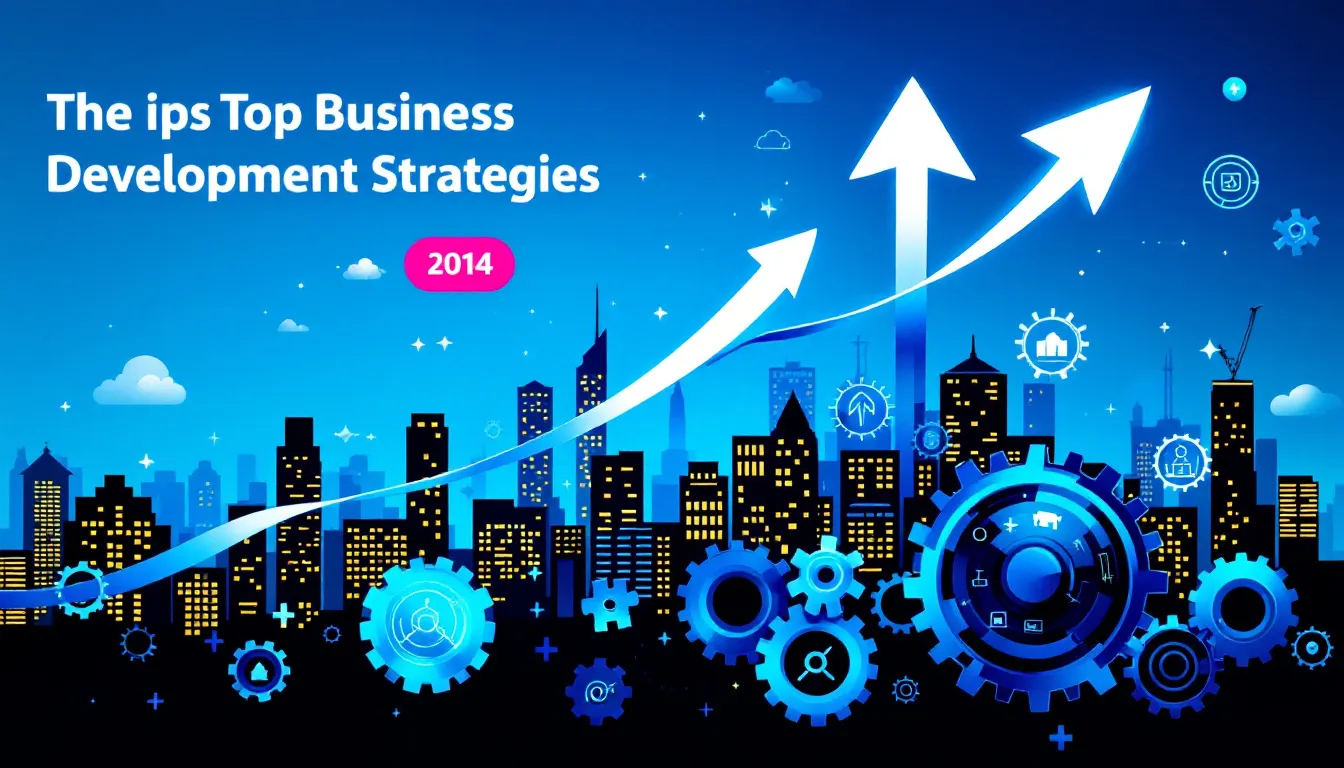Wondering how to effectively grow your professional services firm? Professional services business development is key. This article explores critical strategies, differences from sales, and actionable examples to enhance your business growth.
Key Takeaways
- Business development in professional services focuses on long-term relationship building, client acquisition, and demonstrating value, essential for achieving growth.
- Clear differentiation between business development and sales is crucial, as business development prioritizes strategic partnerships and long-term initiatives over immediate transactions.
- Integrating technology, effective networking, and continuous measurement of KPIs are key tactics for enhancing business development efforts and ensuring sustained success.
Understanding Professional Services Business Development

Business development in professional services is the cornerstone of growth and sustainability. It focuses on:
- Acquiring new business
- Developing relationships
- Uncovering needs
- Communicating value
- Demonstrating impact
- Expanding accounts
For law firms professionals, this translates to attracting new clients, strengthening relationships, and achieving financial goals in their professional life.
Key activities in business development include networking, lead generation activities, and relationship cultivation. Common business development strategies for structuring these activities for optimal resource use enhance effectiveness. Business development conversations and consistent, strategic integration into daily routines are vital for success.
A strategic business development process makes client acquisition easier, more cost-effective, and more lucrative. It allows full control over consulting results with a consistent stream of leads and a diversified client base. Ultimately, it attracts higher-quality clients.
Key Differences Between Business Development and Sales in Professional Services
Business development and sales, though often conflated, serve distinct purposes, especially in professional services firms. Business development encompasses activities beyond closing clients, focusing on long-term growth opportunities like forming partnerships, whereas sales deals with immediate transactions.
The sales process is transactional, focusing on closing deals, while business development is relational, aiming to cultivate ongoing partnerships. Sales development prioritizes quick revenue generation by qualifying leads, whereas business development focuses on strategic initiatives that may take longer to yield results.
Business development professionals need strong sales abilities, effective communication, and negotiation skills. They also explore new technologies and solutions, which is not typically the focus of sales professionals. This broader scope and long-term focus make business development crucial for professional services firms’ growth strategies.
Examples of Business Development in Action
Successful business development requires proactive identification of new clients and potential buyers, which can involve qualifying leads or conducting broader campaigns to uncover opportunities. Consultants, for example, focus on proposing solutions for client outcomes rather than just selling themselves.
Prioritizing building relationships advances prospects, and offering initial services can lower engagement barriers. For example, Greg, the lead architect, balances business development and marketing with client work, showing the importance of integrating these activities into daily routines.
Networking, both in-person and online, is crucial for expanding business development efforts. For instance, Bethany, the Director of Business Development at her firm, focuses on acquiring new contacts and new business through networking and relationship-building.
These examples highlight the multifaceted nature of business development in a professional services firm, which is relevant to many professionals.
Developing a Strategic Business Development Plan
A business development plan details how a strategy will be implemented, serving as a guide for long-term success. It must align with both career and organizational goals. The initial step is to clearly define the target audience, focusing on ideal clients.
Creating a structured plan with clear, actionable steps is a critical step for effective business development. This includes selecting a strategy that aligns with the target audience’s needs and highlights the firm’s competitive strengths. Identifying a competitive advantage involves articulating what makes the firm distinct and how it benefits clients.
Monitoring the business development plan’s implementation and impact helps identify successes and areas needing adjustment. A content or marketing calendar can outline specific actions and their frequencies, ensuring consistent execution of the plan. A mix of traditional and digital tactics effectively engages prospects at various stages of the pipeline.
Top Business Development Strategies for Professional Services Firms

Strategies tailored to current market trends and buyer preferences are crucial for professional services firms’ success. Well-targeted digital advertising has emerged as one of the most promising strategies for reaching the target market. Understanding competitive advantages helps create effective business development strategies.
Aligning strengths with client needs is crucial for choosing an effective business development strategy. Focusing on high-potential prospects enhances business development efforts. Tools like webinars, blogs, and social media can significantly boost visibility for professional services firms.
Attracting more clients and driving growth can be achieved through strategic use of multiple techniques. Regular review and updates of the business development plan ensure alignment with evolving business development goals, keeping firms competitive and growing.
Effective Business Development Tactics
Building awareness and reputation attracts new business through methods like content marketing and networking. Content marketing establishes authority and trust by delivering valuable insights to potential leads. Social media marketing reaches targeted demographics and engages prospects.
Networking is essential for business development, aiming to create relationships with potential clients and collaborators. Digital networking overcomes face-to-face limitations and offers new opportunities. Effective networking involves creating value and listening to others’ needs.
Strategic partnerships enhance growth opportunities by leveraging complementary services. Attending industry events helps stay updated on trends, meet potential clients, and maintain visibility. A well-structured cold email campaign can capture potential clients’ attention. When executed well, these tactics significantly contribute to business development success.
Essential Business Development Skills
Business development professionals need skills in project management, data analysis, and relationship building. Project management is essential for overseeing growth initiatives and ensuring organized execution, helping stay organized and track activities.
Data analytics is crucial for understanding market trends and client needs. Continuous learning and team training help adapt to market dynamics and foster stronger client relationships. These skills are vital for effective business development and achieving goals.
How to Balance Client Work and Business Development Activities
Integrating business development into daily routines helps professionals balance selling activities with primary responsibilities. Successful professionals prioritize business development by dedicating time each day to focused selling activities, ensuring consistent efforts.
A structured approach with specific business development activities helps manage workload during varying client demands. Prioritizing tasks is essential to balance client work and business development. Planning for business development is as important as planning client work to manage responsibilities effectively.
Consultants should aim for an 80% focus on client delivery and 20% on business development. Setting aside daily time for sales and business development ensures consistent and effective efforts.
Leveraging Technology in Business Development
Technology enhances business development by supporting automation, lead nurturing, and effective communication. CRM tools streamline lead management and enhance outreach. Combining human resources and technology boosts efficiency, especially with automation tools.
Consistent follow-up with prospects is essential for moving leads through the sales funnel, facilitated by technology with reminders and organized tracking. Social media platforms also help generate leads and engage potential clients. Integrating technology into business development strategies enhances efficiency and success.
Building and Nurturing Client Relationships

Growing one’s reputation and establishing building trust are crucial for generating new business opportunities and new relationships, leading to increased future engagements and showcasing growth potential. Sustaining and expanding existing client relationships can increase revenue through upselling and cross-selling.
Effective client management significantly impacts small business success. Providing an initial client service offering builds relationships faster, making it easier to offer services to multiple clients and reducing time to revenue. Professionals should develop a process for monitoring and engaging existing accounts for long-term growth.
Driving value with every interaction is essential for effective client management. Consistent follow-ups with leads aid in forming long-term business connections. These strategies ensure nurtured client relationships and ongoing business development success.
Measuring Business Development Success
Key performance indicators (KPIs) help business development teams assess progress and improve strategies. Clear objectives ensure selected KPIs are relevant and aligned with overall business goals. A culture of accountability is fostered through clear definitions of KPIs and individual responsibilities.
Skills in tracking returns on investments (ROI) are vital for justifying business development efforts to leadership. Regular monitoring of KPIs supports continuous improvement and allows teams to adapt strategies based on data insights. Data analytics tools enhance KPI tracking effectiveness and enable real-time performance evaluation.
Business intelligence skills involve researching market needs and analyzing data to inform strategic decisions. These measurement techniques ensure effective and aligned business development efforts, showcasing our technical expertise.
Common Challenges in Business Development and How to Overcome Them
Inconsistent and unplanned activities often hamper business development effectiveness. Many business developers struggle with inadequate market research, leading to poor targeting of prospects. Time management is a frequent challenge, as professionals juggle multiple decision makers and responsibilities.
Building credibility in a competitive market is essential for attracting clients and can be a significant hurdle. Effective networking is crucial for expanding professional connections and opportunities, though it can be challenging. Fostering innovation within the business is tough but necessary to stay relevant in the market.
Dealing with rejection is common in business development and requires resilience. Self-sabotage due to fear and discomfort, second-guessing, and dependency on lower-paying work are common pitfalls for consultants. Overcoming these challenges requires resilience, structured planning, and effective time management to build confidence.
The Role of Thought Leadership in Business Development

Establishing oneself as a thought leader enhances trust and credibility within the industry. Thought leaders can extend their influence beyond the organization, opening up new opportunities. In technical industries, thought leadership can make complex processes more accessible.
Building a reputation through content marketing positions professionals as industry experts, attracting new business. Effective writing attracts potential clients, builds trust, and establishes thought leadership. Public speaking and speaking engagements also play a crucial role in establishing thought leadership.
Hire Business Development Professionals in Latin America
Latin America offers access to a large pool of skilled business development representatives, allowing companies to find top talent efficiently. Hiring business development representatives in Latin America can lead to cost savings of 30-70% compared to hiring in the US. Many business development representatives in Latin America possess near-native English proficiency, facilitating effective communication with US clients.
The hiring process for business development professionals in Latin America can be completed in less than 21 days, ensuring a quick build-up of sales teams. Business development representatives in Latin America are familiar with US time zones, improving collaboration between teams. These benefits make Latin America an attractive region for hiring business development professionals.
Summary
In the ever-competitive landscape of professional services, business development stands as a cornerstone for growth and sustainability. By understanding the nuances of business development, differentiating it from sales, and implementing strategic plans, professionals can drive their firms to new heights. Examples from real-life scenarios illustrate how proactive identification of opportunities and relationship-building can lead to substantial success.
Embracing modern strategies and tactics, leveraging technology, and nurturing client relationships are critical for maintaining a steady stream of business. Measuring success through KPIs and overcoming common challenges ensures continuous improvement. Thought leadership further establishes credibility and opens new avenues. Lastly, hiring skilled professionals, especially from regions like Latin America, can offer significant advantages. The path to business development success is paved with strategic planning, consistent efforts, and a relentless focus on building and nurturing relationships.
Frequently Asked Questions
What is the main difference between business development and sales in professional services?
The main difference between business development and sales in professional services lies in their focus; business development emphasizes long-term growth and relationship-building, whereas sales is primarily concerned with closing immediate transactions.
How can technology enhance business development activities?
Technology significantly enhances business development activities through automation and improved communication. Utilizing CRM tools can streamline lead management and foster effective outreach, ultimately driving growth.
What are some effective business development tactics?
To effectively drive business development, focus on content marketing, social media engagement, networking, forming strategic partnerships, and actively participating in industry events. These approaches will enhance your visibility and foster meaningful professional relationships.
How can professionals balance client work with business development activities?
Professionals can effectively balance client work with business development by integrating these activities into their daily routines, prioritizing tasks, and dedicating specific time each day for focused selling efforts. This structured approach allows for consistent progress while managing responsibilities efficiently.
What role does thought leadership play in business development?
Thought leadership plays a vital role in business development by establishing trust and credibility, making complex concepts more accessible, and attracting new clients. By positioning themselves as industry experts through content marketing and public speaking, professionals can significantly enhance their reputation and business opportunities.
